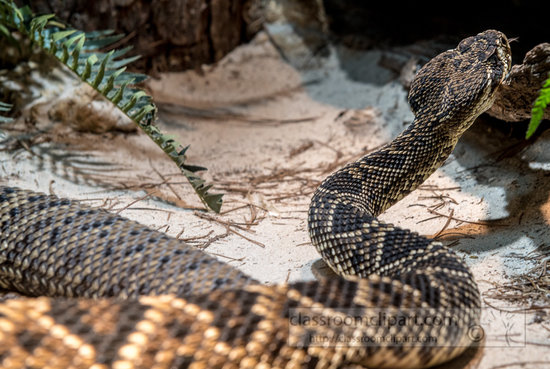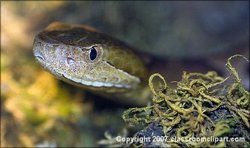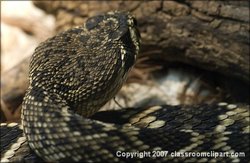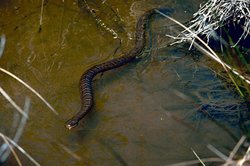Snake
|
|
| Snakes | ||||||||||
|---|---|---|---|---|---|---|---|---|---|---|
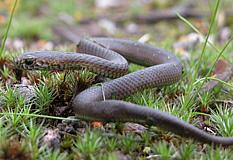 | ||||||||||
| Scientific classification | ||||||||||
| ||||||||||
| Superfamilies and Families | ||||||||||
Snakes are cold blooded legless reptiles closely related to lizards, which share the order Squamata. There are also several species of legless lizard which superficially resemble snakes, but are not otherwise related to them. A love of snakes is called ophiophilia, a fear of snakes is called ophidiophobia (or snakephobia), a specialist in snakes is an ophiologist.
An old synonym for snake is serpent; in modern usage, this usually refers to a mythic or symbolic snake, and information about such creatures will be found under serpent. This article deals with the biology of snakes.
| Contents |
Evolution
The phylogeny of snakes is poorly known. Snake skeletons are fragile and unlikely to fossilize. However, it is generally assumed that snakes derived from lizard-like ancestors.
The likeliest ancestors are thought to be mosasaurs – extinct aquatic reptiles from the Cretaceous – which in turn are thought to have derived from varanid lizards. Features such as lack of eyelids and lack of external ears are thought to have evolved to combat marine conditions, leading to a snake similar in appearance to sea snakes of today. In the Late Cretaceous, snakes would remerge from the ocean onto land as they are today. The best fossil snake remains, from Late Cretaceous marine sediments, support this theory. Similar skull structure; reduced/absent limbs; and other anatomical features found in both mosasaurs and snakes lead to a positive cladistical correlation, though some features are also shared with varanids. Supposedly similar locomotion for both groups is also use as support.
A secondary hypothesis is that snakes directly evolved from varanids similar to the earless monitor of Borneo. Like this monitor, theoretical ancestors would have been land-burrowers. As these ancestors became more subterranean, they lost their limbs and became more streamlined for burrowing. Features such as lack of eyelids and external ears are thought to have evolved to combat subterranean conditions. In the Late Cretaceous, snakes would, as with the marine origin theory, re-emerge onto land as they are today.
Fragmentary remains that have been found from the Early Cretaceous may refute either theory, though. Additionally, genetic tests have been performed that show no close affinity to varanids and thus to mosasaurs either. These tests did not show to which lizard family snakes more closely align, either, allowing for more debate.
Feeding
All snakes are carnivorous, eating small animals including lizards and other snakes, rodents and other small mammals, birds, eggs or insects. Some snakes have a venomous bite which they use to kill their prey before eating it. Other snakes kill their prey by constriction resulting in death by strangulation.
Snakes do not chew their food. Snakes have a very flexible lower jaw, the two halves of which are not rigidly attached, and numerous other joints in their skull (see snake skull), allowing them to open their mouths wide enough to swallow their prey whole, even if it is larger in diameter than the snake itself. Contrary to the popular myth, at no point do they "unhinge" their jaws (disarticulate their mandibular joints).
After eating, snakes become torpid while the process of digestion takes place. Digestion is an intensive activity, especially after the consumption of very large prey, and so much metabolic energy is involved that Crotalus durissus, the Mexican rattlesnake, may actually raise its body temperature as much as 6 degrees above the surrounding environment. Because of this, a snake disturbed after having eaten recently will often regurgitate the prey in order to be able to escape the perceived threat. However, when undisturbed, the digestive process is highly efficient, dissolving and absorbing everything but hair and claws, which are excreted along with uric acid waste.
Snakes do not normally prey on people, but there are instances of small children being eaten by large constrictors in the jungle. While some particularly aggressive species exist, most will not attack humans unless startled or injured, preferring instead to avoid contact. In fact, most snakes are non-venomous or have venom that is not harmful to humans.
Skin
The skin is covered in scales. Most snakes use specialized belly scales to move, gripping surfaces. The body scales may be smooth, keeled, or granular. Their eyelids are transparent "spectacle" scales which remain permanently closed. They shed their skin periodically. Unlike other reptiles, this is done in one piece, like pulling off a sock. It is thought that the primary purpose of this is to remove external parasites. This periodic renewal has led to the snake being a symbol of healing and medicine, as pictured in the Rod of Asclepius. In "advanced" (Caenophidian) snakes, the broad belly scales and rows of dorsal scales correspond to the vertebrae, allowing scientists to count the vertebrae without dissection
Perception
While snake vision is unremarkable (generally being best in arboreal species and worst in burrowing species), it is able to detect movement. In addition to their eyes, some snakes (pit vipers, pythons, and some boas) have infrared sensitive receptors in deep grooves between the nostril and eye which allow them to "see" the radiated heat. As snakes have no external ears, hearing is restricted to the sensing of vibrations, but this sense is extremely well developed. A snake smells by using its forked tongue to collect airborne particles then passing them to the Jacobson's organ in the mouth for examination. The fork in the tongue gives the snake a sort of directional sense of smell.
Internal organs
The left lung is very small or sometimes even absent, as snakes' tubular bodies require all of their organs to be long and thin, and to accommodate them all only one lung is functional. Also, many organs that are paired, such as kidneys or reproductive organs, are staggered within the body, with one located ahead of the other. The most primitive snakes, including boas and pythons, have anal spurs, a pair of claws on either side of the cloaca which are the vestiges of limbs. The leg bones and remains of the pelvis are embedded within the body in these species.
Locomotion
Snakes utilize a variety of methods of movement which allow them substantial mobility in spite of their legless condition. All snakes are capable of lateral undulation, in which the body is flexed side-to-side, and the flexed areas propagate posteriorly, giving the overall shape of a posteriorly propagating sine wave. In addition, all snakes are capable of concertina movement. This method of movement can be used to both climb trees and move through small tunnels. In the case of trees, the branch is grasped by the posterior portion of the body, while the anterior portion is extended. The anterior portion then grasps the branch, and the posterior portion is pulled forward. This cycle may occur in several sections of the snake simultaneously. In the case of tunnels, instead of grasping, the body loops are pressed against the tunnel walls to attain traction, but the motion is otherwise similar. Another common method of locomotion is rectilinear locomotion, in which the snake remains straight and propels itself via a caterpillar-like motion of its belly-muscles. This mode is usually only used by very large, heavy snakes, such as large pythons and vipers. The most complex and interesting mode is sidewinding, an undulatory motion used to move across slippery mud or loose sand.
Not all snakes dwell on land; sea snakes live in shallow tropical seas.
Reproduction
A wide range of reproductive modes are used by snakes. All snakes employ internal fertilization, accomplished by means of paired, forked hemipenes, which are stored inverted in the male's tail. Most snakes lay eggs, and of those most species abandon them shortly after laying; however, some species are ovoviviparous and retain the eggs within their bodies until they are almost ready to hatch. Recently, it has been confirmed that several species of snake are actually fully livebearing, nourishing their young through a placenta as well as a yolk sac. Retention of eggs and live birth are commonly, but not exclusively, associated with cold environments, as the retention of the young within the female allows her to control their temperature more effectively than if the developing young were in external eggs.
Surviving venomous snake bites
There is little reason to fear death from snake bites. Only a quarter of snakes are venomous, and among the 7,000 Americans bitten by venomous snakes every year, fewer than fifteen die (lightning kills more). However, if you are bitten by a snake, there are certain procedures to follow. Firstly, move away from the attacking snake. Secondly, check for one or two puncture wounds on your body. If the site of the bite begins to swell and hurt terribly, then you have been envenomated. If possible, keep the wound below your heart and slowly begin to move toward medical attention. The venom alone is usually not enough to kill you, but overexerting yourself while envenomated can. Do not tie off the affected area to prevent the venom from spreading, as lack of blood circulation may cause tissue death. Moreover, the venom spreads throughout the circulatory system almost instantaneously upon entry and frantic running speeds the delivery. Despite popular belief, you cannot suck out snake venom with your mouth. Finally, medical care has to be availed of without delay as anti-venom can almost always cure any lethal bite.
Lethal venomous snakes
While only a quarter of snakes are venomous, there are various species that are lethal to humans. The following groups of lethal snakes can be aggressive and their venom can kill a healthy adult if left untreated for several hours. This list is incomplete.
- Cobra
- King Cobra
- Mamba
- Death adder
- Taipan
- Saw-scaled Viper
- Gaboon Viper
- Pit Viper
- Boomslang
- Tiger snake
- Brown snake
- Black snake
- Rattlesnake
- Coral Snake
- Urutu
- Russell's viper
Snake charmers
In some parts of the world, especially in India, snake charming is a roadside show performed by a charmer. In this, the "snake charmer" carries a basket that contains a snake that he "charms" by singing tunes from his flute like musical instrument, to which the snake responds. However, snakes are deaf they cannot hear the charmer's unique flute. Researchers have pointed out that these snake charmers are good sleight-of-hand artists. The snakes move corresponding to the flute movement and the vibrations from the tapping of the charmer's foot which is not noticed by the public. They rarely catch their snakes and the snakes are either nonvenomous or defanged cobras. Sometimes these people exploit the fear of snakes by released snakes into the neighborhood and claim to rid the residence of snakes. Other snake charmers also have a snake and mongoose show where both the animals have a mock fight.
Snake trapping
Despite the existence of snake charmers, there have also been professional snake catchers. The tribals of "Irulas" from Andhra Pradesh and Tamil Nadu in India have been practicing this art for generations. They generally don't use gimmicks and with the help of a simple stick catch the snakes from the fields or houses. They are also known to eat some of the snakes they catch and are very useful in rat extermination in the villages. Their knowledge of snakes and their behavior is uncanny. Modern-day snake trapping involves an ornithologist using a long stick with a "V" shaped end. Some prefer to catch them using their own hands.
Human consumption of snakes
In some cultures, the consumption of snakes is acceptable[1] (http://www.economist.com/displayStory.cfm?story_id=1487714) or even considered a delicacy[2] (http://www.asiatour.com/x-librar/dining/chinese.htm), prized for its alleged pharmaceutical effect of warming the heart. It is reported to taste like chicken[3] (http://www.asiatour.com/x-librar/dining/chinese.htm). Western cultures document the consumption of snake under extreme circumstances of hunger[4] (http://skyways.lib.ks.us/kansas/ksevents/rsru). However, human consumption of these snakes, especially the uncooked ones, may often cause deadly infection from rare parasites.
Snakes in Culture & media
Snakes have been found in various cultures and have been worshipped at various times for their unique abilities.
Egypt
In Egyptian history, the snake occupies a primary role with the Nile cobra adorning the crown of the pharaoh in ancient times. It was worshipped as one of the Gods and was also used for sinister purposes including killing an opponent or for suicide as Cleopatra did.
Hinduism
Called the land of snakes, India is steeped in tradition with snakes. Snakes are worshipped as gods even today with many women pouring milk on snake pits (despite snakes' aversion for milk). The cobra is seen on the neck of Shiva and Vishnu is depicted often as sleeping only on a 7 headed snake. There are also several temples in India solely for cobras sometimes called Nagraj (King of Snakes) and it is believed that snakes are symbols of fertility.
Christianity
In Christianity, the snake makes its infamous appearance in the first book of the bible when the devil appears before the first couple Adam and Eve and tempts them with the forbidden fruit. It is also seen when Moses turns his stick into a snake to devour the pharaoh's snake and later carves out a cross with a snake to cure his people in the desert.
Clipart and Animal Pictures
- Clipart (https://classroomclipart.com/image/category/clipart.htm)
- Animal Clipart (https://classroomclipart.com/image/category/animal-clipart.htm)
- Animal Animated Clipart (https://classroomclipart.com/clipart/Animations/Animals.htm)
- Pictures of Animals (https://classroomclipart.com/image/category/animal-photos.htm)
- Amphibian Clip Art, Pictures and Photogaphs (https://classroomclipart.com/image/category/amphibian-clipart.htm)
- Farm Animal Clip Art, Pictures and Photographs (https://classroomclipart.com/image/category/farm-animal-clipart.htm)
- Mammal Clip Art, Pictures and Photographs (https://classroomclipart.com/image/category/mammal-clipart.htm)
- Marine Animal Clip Art, Pictures and Photographs (https://classroomclipart.com/image/category/marine-life-clipart.htm)
- Reptile Clip Art, Pictures and Photographs (https://classroomclipart.com/image/category/reptile-clipart.htm)
- Spider Clip Art, Pictures and Photographs (https://classroomclipart.com/image/category/spider-clipart.htm)
Classification
Order:Squamata
- Suborder Serpentes
- Superfamily Typhlopoidea (Scolecophidia)
- Family Anomalepidae: dawn blind snakes
- Family Typhlopidae: blind Snakes
- Family Leptotyphlopidae /Glauconiidae: slender blind snakes
- Superfamily Henophidia (Boidea)
- Family Aniliidae /Ilysiidae: pipe snakes
- Family Anomochilidae dwarf pipe snakes
- Family Boidae: boas
- Family Pythonidae: pythons
- Family Bolyeridae: Round Island boas
- Family Cylindrophiidae: Asian pipe snakes
- Family Loxocemidae: Mexican burrowing pythons
- Family Tropidophiidae
- Family Ungaliophiidae: dwarf boas
- Family Uropeltidae: shield-tail Snakes
- Family Xenopeltidae: Sunbeam Snakes
- Family Acrochordidae: file snakes
- Superfamily Xenophidia (Colubroidea = Caenophidia)
- Family Atractaspididae: mole vipers
- Family Colubridae: colubrids (over half of all snake species, such as garter snake, rat snake, milk snake, king snake)
- Family Elapidae: cobras, kraits, coral snakes, Australian copperheads
- Family Hydrophiidae: sea snakes
- Family Viperidae: vipers and pit vipers (e.g. rattlesnake, American copperhead)
- Superfamily Typhlopoidea (Scolecophidia)

